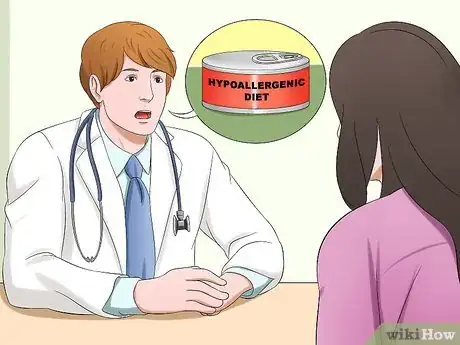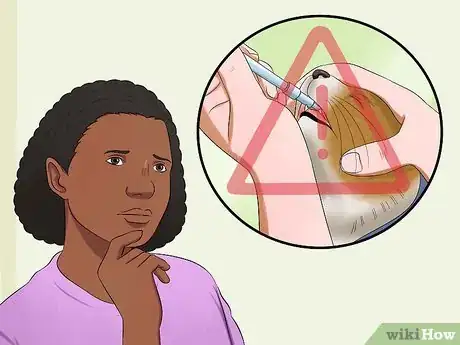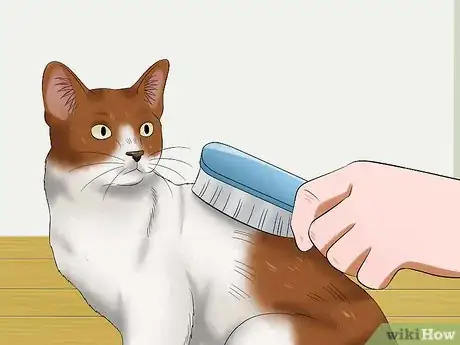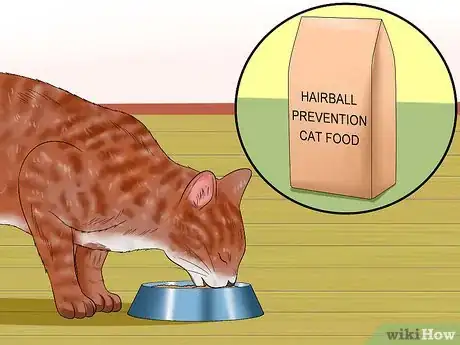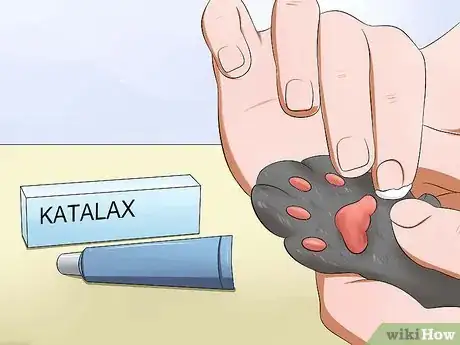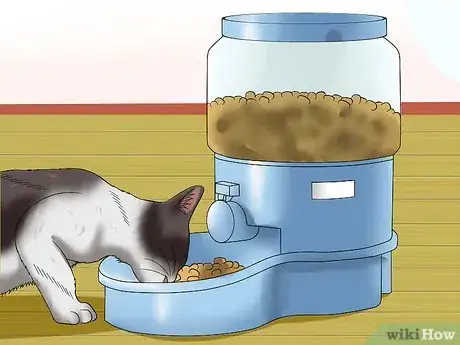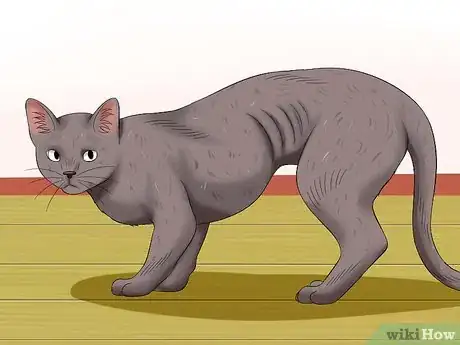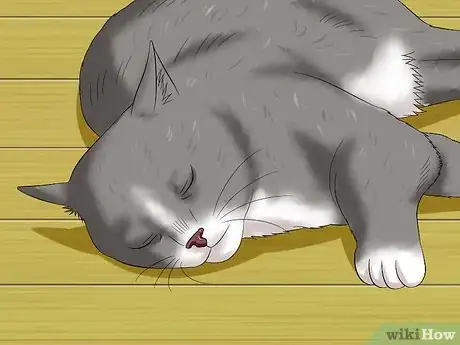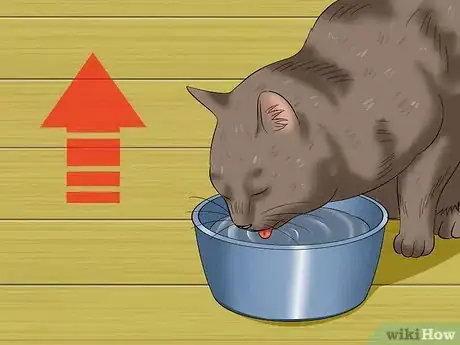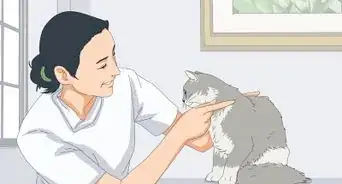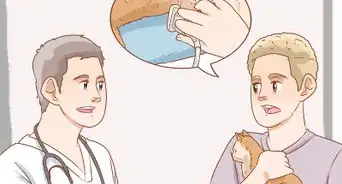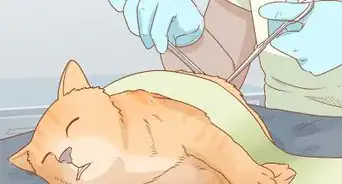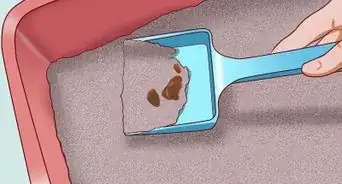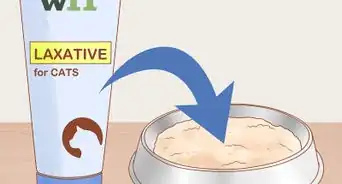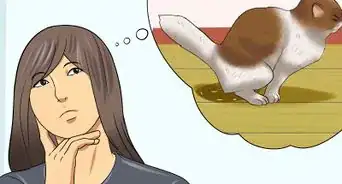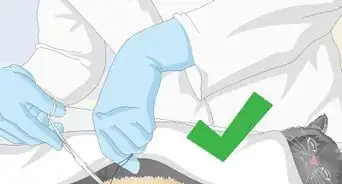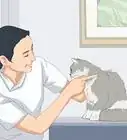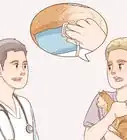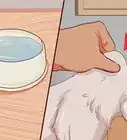This article was co-authored by Pippa Elliott, MRCVS. Dr. Elliott, BVMS, MRCVS is a veterinarian with over 30 years of experience in veterinary surgery and companion animal practice. She graduated from the University of Glasgow in 1987 with a degree in veterinary medicine and surgery. She has worked at the same animal clinic in her hometown for over 20 years.
This article has been viewed 126,893 times.
Occasional vomiting can be perfectly normal in a cat.[1] However, if it's out of character for your cat to vomit, the frequency of vomiting increases, or the cat loses weight or seems unwell, then veterinary attention should be sought. In the meantime, there are some simple methods to help your cat feel better and stop vomiting.
Steps
Ruling Out Causes
-
1Check when your cat was last dewormed. An infestation of worms, such as tapeworms, can cause your cat to vomit.[2] By deworming your cat, you will be able to either stop the vomiting from occurring, or at least rule out this as a cause.[3]
- Deworm your cat more often — once a month at minimum — if they are allowed to hunt.
- If your cat is behind on their deworming, get them up to date.
- There are many dewormers available to purchase. Different products have different spectrums of effectiveness, thus deworming your cat is not a guarantee all the worms are gone. On occasions it is necessary for your vet to analyze a fecal specimen to identify any worms that have survived treatment.
- Use, selamectin (Revolution), for roundworms.[4]
- Use, milbemycin (Interceptor), to remove many types of worms.[5]
-
2Be aware of potential allergens. Many cats have allergies, particularly to proteins. Your cat may have an intolerance to a component of their diet. Identify and remove any allergens from the cat's diet.[6]
- Ask your vet about hypoallergenic diets.
- Use a hypoallergenic diet for at least eight weeks, to ensure the allergen has passed.[7]
- Slowly introduce new foods, one at a time, and check for any that trigger vomiting.
- Some cats will vomit almost immediately after eating the allergen, but others may take hours to vomit. Generally, when the allergen reaches the stomach, irritation occurs, which results in vomiting.[8]
Advertisement -
3Check if your cat has started any new medications. Cats are very sensitive to medications and many medications have the side-effect of causing vomiting. Take note of any medications you may have given your cat and see if they might be responsible for the vomiting.
- Your veterinarian will be able to tell you more about complications from medication.
- If a medication is the cause of the vomiting, ask your veterinarian for alternative.
- Cats are extremely sensitive to medications, home remedies should not be administered.
Taking Direct Actions
-
1Brush your cat daily. Hairballs are common in cats and are a result of your cat’s normal grooming habits. When cats groom themselves, they ingest hair, which can irritate the stomach, inducing vomiting. By brushing your cat, you minimize the amount of hair it might ingest, preventing your cat from vomiting a hairball.
- Brush your cat daily.
- Brush both long and short haired cats.
- Use a comb to remove knots.
- Use a rubber brush to remove loose hairs.
-
2Feed your cat hairball-prevention dry food. There are several kinds of cat food on the market designed to minimize hairballs. Try to choose a dry food formula which has high fiber content.[9]
- Fiber helps hair to pass through the digestive system.
-
3Use a gentle cat lubricant paste. If your cat frequently has hairballs, you might consider keeping a cat lubricant paste on hand. These lubricants are designed to help cats pass hairballs.[10]
- A number of different products exist, such as Lax-a-paste or Katalax.
- Many are made of inert liquid paraffin and are often given a flavor so your cat will lick it.
- Apply about one inch to the cat's paw, twice a day for two to three days, so that it licks it off.
- The paste coats the hairball and either helps it pass out in the feces.
-
4Slow your cat down when it eats. Some cats eat quickly and in doing so swallow a lot of air with its food. This can cause its stomach to become irritated and it will vomit shortly after eating. Stop this behavior with a few simple actions:
- Give your cat their meal in a puzzle feeder or a food toy.
- Divide its food in a muffin tray to make smaller portions and slow down its eating.
- There are already many devices for purchase that are designed to dispense food slowly.
Deciding Whether to Take Your Cat to the Vet
-
1Watch for weight loss. A healthy cat that vomits should not lose weight. If your cat is vomiting at least two or three times a week and losing weight, take them to the vet. You should also take your cat to the vet if you notice the following symptoms of intestinal dysfunction:[11]
- Soft feces
- Feces with blood
- Feces with Mucus
- Diarrhea
-
2Watch for a change in behavior. Look for any behaviors in your cat that are not normally present. These behaviors could include many things, but if they seem to be out of character for your cat, take them to the veterinarian. Check the following list for some examples of things to look for:[12]
- Lack of energy, tired, or lethargic.
- Quiet, withdrawn, or listless.
- Extremely vocal or hyperactive.[15]
-
3Watch for a change in eating or drinking habits. Keep an eye on how often your cat is eating and drinking. Also watch for the amount they are consuming, both in food and drink. If your cat presents any abnormalities in their appetite or thirst, take them to your vet.
- If your cat is drinking or eating much less, and losing weight, visit your vet.
- If you cat is drinking much more than usual, visit your vet.
-
4Go to your veterinarian if in doubt. It's not always easy to identify what the problem might be. Your veterinarian will be able to pinpoint the cause of your cat vomiting and help to discover if it is symptomatic of something more serious such as:
- Pancreatitis
- Kidney disease
- Liver disease
- Inflammatory bowel disease
- Worms
- Infections
Expert Q&A
-
QuestionOur cat has late stage feline leukemia, has lost weight, and vomits everything he eats (pureed chicken). How can we help him keep food down?
 Pippa Elliott, MRCVSDr. Elliott, BVMS, MRCVS is a veterinarian with over 30 years of experience in veterinary surgery and companion animal practice. She graduated from the University of Glasgow in 1987 with a degree in veterinary medicine and surgery. She has worked at the same animal clinic in her hometown for over 20 years.
Pippa Elliott, MRCVSDr. Elliott, BVMS, MRCVS is a veterinarian with over 30 years of experience in veterinary surgery and companion animal practice. She graduated from the University of Glasgow in 1987 with a degree in veterinary medicine and surgery. She has worked at the same animal clinic in her hometown for over 20 years.
Veterinarian Pureed chicken is very bland and he really should be able to keep this down. Assuming you are giving him little and often, then update the vet about this development. They may be able to suggest anti-sickness medications to control the vomiting (like in a chemotherapy patient) or antacids to line the stomach. However, do keep a close eye on the cat's quality of life and make a brave decision before he suffers.
Pureed chicken is very bland and he really should be able to keep this down. Assuming you are giving him little and often, then update the vet about this development. They may be able to suggest anti-sickness medications to control the vomiting (like in a chemotherapy patient) or antacids to line the stomach. However, do keep a close eye on the cat's quality of life and make a brave decision before he suffers. -
QuestionMy cat is eating less and started vomiting and pooping in the house. Is she sick?
 Pippa Elliott, MRCVSDr. Elliott, BVMS, MRCVS is a veterinarian with over 30 years of experience in veterinary surgery and companion animal practice. She graduated from the University of Glasgow in 1987 with a degree in veterinary medicine and surgery. She has worked at the same animal clinic in her hometown for over 20 years.
Pippa Elliott, MRCVSDr. Elliott, BVMS, MRCVS is a veterinarian with over 30 years of experience in veterinary surgery and companion animal practice. She graduated from the University of Glasgow in 1987 with a degree in veterinary medicine and surgery. She has worked at the same animal clinic in her hometown for over 20 years.
Veterinarian What you describe is consistent with a cat that has a medical problem. Any cat that is vomiting and seems unwell or not herself should see the vet. It will help the vet to know what's wrong if you monitor how much she drinks and what her poop looks like.
What you describe is consistent with a cat that has a medical problem. Any cat that is vomiting and seems unwell or not herself should see the vet. It will help the vet to know what's wrong if you monitor how much she drinks and what her poop looks like.
Warnings
- If your cat is exhibiting symptoms in addition to vomiting, take it to your veterinarian.⧼thumbs_response⧽
- If you are unsure if your cat's vomiting or behavior is normal, schedule an examination with your veterinarian.⧼thumbs_response⧽
References
- ↑ https://www.aspca.org/pet-care/cat-care/vomiting
- ↑ https://www.aspca.org/pet-care/cat-care/worms
- ↑ Plumb's Veterinary Drug Handbook. Donald Plumb. Publisher: Wiley-Blackwell
- ↑ Plumb's Veterinary Drug Handbook. Donald Plumb. Publisher: Wiley-Blackwell
- ↑ Plumb's Veterinary Drug Handbook. Donald Plumb. Publisher: Wiley-Blackwell
- ↑ Food hypersensitivity - new recommendations for diagnosis and management. Rosser. Consultations in Feline Internal Medicine. WB Saunder.
- ↑ Food hypersensitivity - new recommendations for diagnosis and management. Rosser. Consultations in Feline Internal Medicine. WB Saunder.
- ↑ Food hypersensitivity - new recommendations for diagnosis and management. Rosser. Consultations in Feline Internal Medicine. WB Saunder.
- ↑ Small Animal Internal Medicine. Nelson & Couto. Publisher: Mosby.
- ↑ Small Animal Internal Medicine. Nelson & Couto. Publisher: Mosby.
- ↑ https://www.aspca.org/pet-care/cat-care/vomiting
- ↑ https://www.aspca.org/pet-care/cat-care/vomiting
- ↑ Small Animal Internal Medicine. Nelson and Couto. Publisher: Mosby
About This Article
To help a cat not throw up, get it dewormed to make sure tapeworms aren’t causing the problem. You should also check to see if you’ve been giving it any medications that have vomiting as a side effect, and ask your veterinarian for an alternative if you think it’s the problem. If the problem persists, put the cat on a hypoallergenic diet for 8 weeks, then slowly reintroduce foods 1 at a time to see if they cause a problem. Scroll down for advice from our Veterinary reviewer on how to tell how bad your cat's illness is.

